New Mazda powered USF2000 Tatuus USF-17 completes six-day testing program.

The Mazda powered, Cooper Tire shod, Tatuus designed USF-17 completed it’s successful six day shake-down testing today with a final one-day test on the oval at Lucas Oil Raceway.
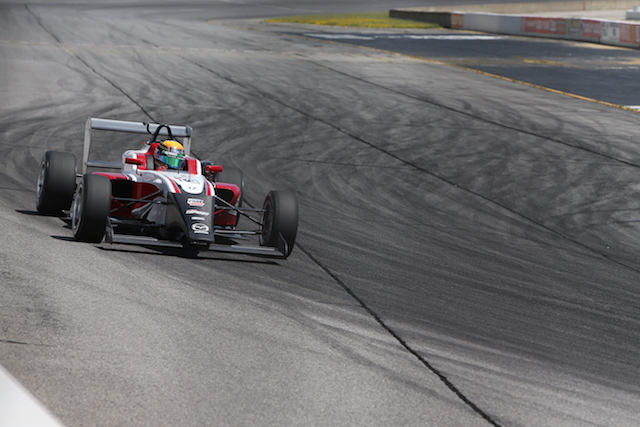
The USF-17 also spent time testing at the National Corvette Museum Motorsports Park, Barber Motorsports Park, and Road America.
Handling driving duties for the first five days of testing was Joel Miller. Miller is currently the USF2000 driver coach/steward, while also helping develop and pilot Mazda’s factory prototype program in the WeatherTech SportsCar Championship. The 28 year-old with a mechanical engineering degree from the University of California Riverside has previous F2000 experience, was the 2007 Skip Barber National champion and the Pro (Star) Mazda vice -champion in 2008.
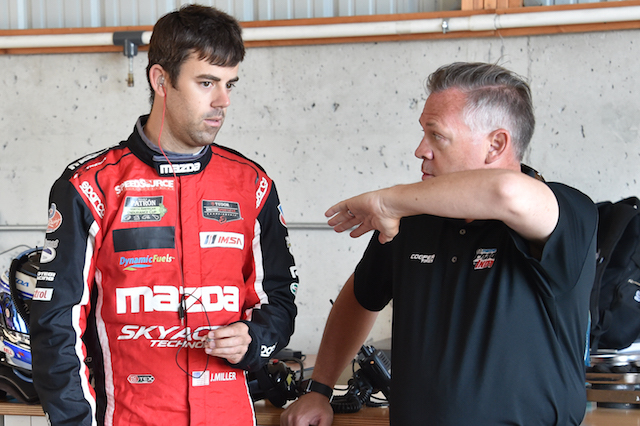
Miller told TSO that “getting back into an open wheel car again (Indy Lights in 2011 was his last time), puts a big smile on his face.”
Matthew Brabham, the 2012 USF2000 champion, USF2000 race winner at Lucas Oil Raceway, and 100th running of the Indianapolis 500 participant, took over the testing at the 0.686 mile Brownsburg, Indiana oval.
“It’s an honor to test the new chassis,” said Brabham.
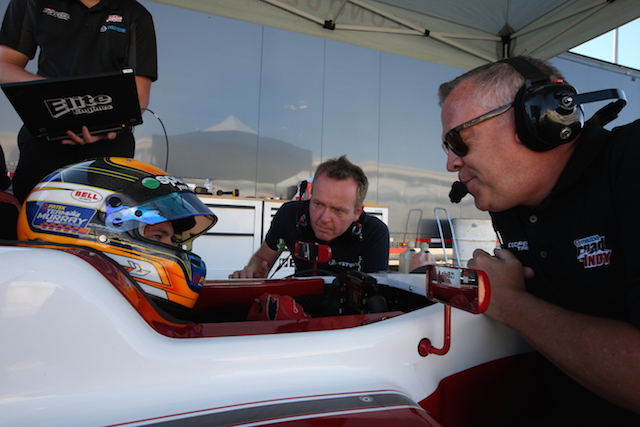
“Today went really smoothly. We had no issues and ran tons of laps. The systems in the car are a big upgrade compared to the old car, which makes it a lot more comfortable to drive.
“It felt really quite different from the old USF2000 car and had different characteristics in the way it drives and handles obviously.”
Scot Elkins, project manager and USF2000/Pro Mazda Race Director, was chosen to by Dan Andersen to lead the bottom two rungs of the Mazda Road To Indy into the car of the future. Elkins, a Terre Haute, Indiana native, has extensive experience dealing with complex projects that involves multiple manufacturers, and was the perfect choice to develop the car that will produce the next generation of open-wheel pilots.
The Indiana State grad, who is also currently the Chief Operating Officer at the Motorsport Safety Foundation served as the Technical Director for Champ Car from 2004 through it’s merger with the Indy Racing League in 2008. During that time Elkins, who has also spent six years leading the IMSA competition department, was the project manager for the introduction of the Atlantic Series Swift 016.a and Champ Car’s DP-01.
Each day of testing consisted of similar programs. Before lunch, Elkins would guide a team of Mazda Road To Indy, Tatuus , Cooper Tire, Elite Engine, Cosworth and PFC engineers, mechanics and technicians while working on basic car set-up through the use of shorter on-track runs.
After a quick break for lunch, the driver would take on a large chunk of the work load, doing multiple race length runs to test the validity of earlier findings.
Sharing a common tub with the Tatuus F4-T014 FIA Formula 4 chassis, the USF-17 features numerous additional safety and performance upgrades.
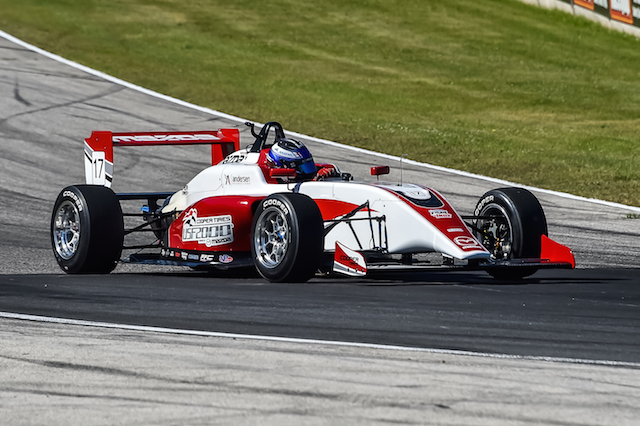
The Tatuus F4-T014 is most popular F4 chassis in use worldwide and is the basis of the: Italian Formula 4 Championship, ADAC Forumla 4 (Germany, Austria and the Netherlands), SMP F4 Championship (Russia, Sweden, Finland and Estonia), Spanish Formula 4 Championship and the United Arab Emerates Formula 4 Championship.
Jeff Horton, INDYCAR’s director of engineering has been working with Elkins on all of the upgraded safety enhancements which include a double bulkhead, side intrusion panels, front and rear wheel tethers, and an INDYCAR type head surround.
Upgrading the performance from a standard F4 package will be:
- the 170hp proven Mazda MZR 2.0 liter engine built by Elite Engines
- adjustable twin element rear wing
- 13×8 (front) and 13 x10 (rear) wheels
- PFC Formula 3 quality brakes with driver adjustable brake bias
- upgraded Cosworth electronics package including ECU, GCU and data logger
- three way adjustable Dynamic dampers with Hyperco springs (six spring rates available)
- upgraded uprights for oval racing
- ride-height, camber, toe adjustment, roll center, anti-squat and anti-dive adjustments on the rear axle and ride-height, camber and toe adjustment available on the front axle.
The first container of 15 USF-17’s will loaded by Tatuss in Italy in the middle of August and teams should be receiving their brand new cars by the middle of September. The second container is scheduled to arrive in November or December and
TSO has learned that only four of the chassis in the first container of 15 cars are destined for existing Cooper Tires USF2000 Powered by Mazda teams.
Exclusive Autosport is the first new team that has announced that they will joining the Mazda Road To Indy. The Saskatoon, Saskatchewan based squad is led by Michael Duncalfe, a former Star Mazda pilot and entrepreneur, and they have captured multiple Formula F/F1600 titles since 2013.
We have heard some other very intriguing team names that are set to join or re-join the Mazda Road To Indy, including a former championship winning Atlantic Championship team and a current SCCA Pro championship winning team (also former USF2000 competitors).
Some thoughts from Steve.
So how did the USF-17 perform in testing?
Lap times were official, but after some new car gremlins appeared during the first day of testing at National Corvette Museum Motorsports Park, the lap times for a brand new car, with only a couple of days of development work were outstanding. TSO learned that the USF17 was:
- at 2016 race-pace and within a half-second of pole at Barber Motorsports Park
- above 2016 race pace and good enough to qualify in the top 10 at Road America
- at race and qualifying pace at Lucas Oil Raceway
Very impressive, especially for a brand-new car that has had no team development and and also has only half of the downforce that the current Van Diemen package currently races with.
Re: that reduced downforce. That, at least in my (Steve’s) opinion, is the best thing that could happen to entry level series of the Mazda Road To Indy.
First, it allows drivers skipping F1600 and coming straight from karting to USF2000, a chance to develop a better feel for mechanical grip. That is a skill that becomes very important as they continue to progress up the open wheel ladder.
“The car will stay much more competitive across a long run without degradation,” declared Miller. “ And, as the fuel bleeds off, the balance changes which is something these drivers will deal with all the way up the ladder – and they’ll learn it now on the first level.”
Second, it should greatly improve the racing. Due to the current high downforce levels, following closely on the high speed corners of a natural terrain circuit and oval is an issue with the current package. The lower downforce USF-17 should allow drivers to follow each other more closely, making it easier to pass and improving the racing.
“It has less aero and downforce which makes the car slide around slightly more,” explained Brabham. “I think it will be fantastic for learning car control especially on the ovals. Hopefully it will make the racing closer and tighter too without as much aero wash in traffic.
“The mechanical grip from the Tatuus chassis is also a big improvement compared to the old car. It makes up for the less downforce.
How does the future of the lowest rung of the Mazda Road To Indy look?
Bright. Very Bright.
With 24 solid orders placed by 14 different entities, and more orders expected any day, the first two 15-car containers should be filled by the time the first batch are loaded into a container for the trip from Italy to the United States in mid-August.
The majority of current USF2000 teams (owners and drivers) stuck around for the test day at Road America, and the excitement among the team principals was quite evident.
One long-time USF2000 team owner told TSO that while the current car (a 10+ year old Van Diemen design, based off of a 30 year old car) has been a good one, it was time to catch up to the rest of the world and modernize the bottom rung of the Mazda Road To Indy.
Current USF2000 rookie Dakota Dickerson was interested spectator and is very keen to help a team develop the new car and the 20 year-old Mazda backed pilot clearly understands the benefit that can have in his future career development.
“The teams all love it, said Anderson. “Some teams are thinking about adding to the orders they have already made, and we have more serious potential buyers than we have cars left in the first order of 30. I couldn’t be happier with our next generation car.”
As is always the case in racing, the running costs of a car will determine whether or not it is successful. One of the primary goals that Elkins and Andersen have kept in mind from day one was reducing the operating costs for the teams. The cost of a rolling chassis is $51,800, and Andersen has made a strong effort to keep the cost of consumables at a manageable level.
“The component usage is fantastic,” explained Andersen. “Brake wear is better by far than the current car, as is the tire wear.”
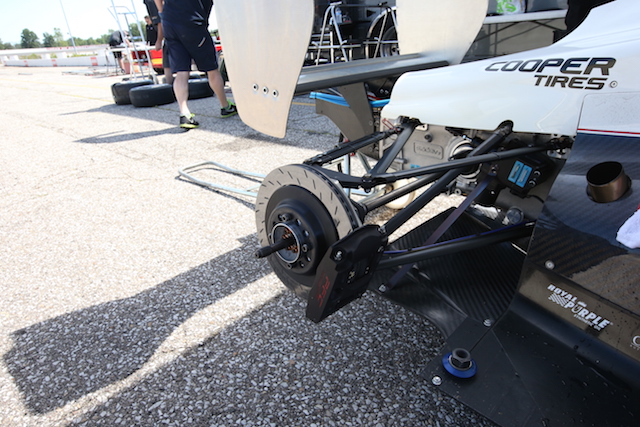
“At Barber, we did three straight sets of mock qualifying and a race and the brake pads looked nearly brand new after 600 miles,” added Miller. “As far as wear and tear and consumables, this car is much more cost effective.”
A different business model?
Another positive that you won’t hear mentioned too much, but that could potentially be huge junior series business model game changer, is that the purchase of this Tatuss chassis will be a great investment for a driver, parent, or long time sponsor. Because the basic tub will form the basis of both the USF2000 and Pro Mazda car, the $51,800 rolling chassis cost of the car can be spread out over a three or four year program. A true win-win-win situation for the parents/sponsors, teams and series.
It’s a win for the parent/sponsor because not only can the cost of the chassis be spread out over a multiple year program, the car will still have considerable value and will be easily sold.
It’s a win for the teams because they don’t have the initial capital outlay. Most junior level open wheel teams operate on such razor thin margins, not having that initial outlay could easily be the difference between continuing and not continuing.
It’s a win for the series because they have now have driver via their parents that are more invested to see out a three or four year program.
The next time the public and media will have the opportunity to see the US-17 run in anger, it will be in the hands of teams at the teams at the Chris Griffis Memorial Test. The annual off-season test will move back to the Indianapolis Motor Speedway again in 2016, and is scheduled to take place on October 8th and 9th.
